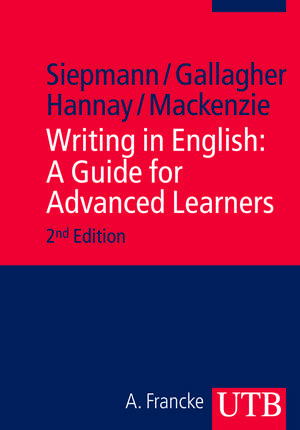Writing in English: A Guide for Advanced Learners: Uni-Taschenbücher, cartea 3124
Autor Dirk Siepmann, John D. Gallagher, Mike Hannay, Lachlan Mackenziede Limba Germană Paperback – 13 sep 2011
This third edition has been thoroughly revised, updated and expanded to include, among other things, advice on how to use new Internet technology.
Din seria Uni-Taschenbücher
-
 Preț: 291.81 lei
Preț: 291.81 lei -
 Preț: 133.11 lei
Preț: 133.11 lei -
 Preț: 131.69 lei
Preț: 131.69 lei -
 Preț: 224.48 lei
Preț: 224.48 lei -
 Preț: 136.83 lei
Preț: 136.83 lei -
 Preț: 180.88 lei
Preț: 180.88 lei -
 Preț: 445.48 lei
Preț: 445.48 lei -
 Preț: 153.91 lei
Preț: 153.91 lei -
 Preț: 132.42 lei
Preț: 132.42 lei -
 Preț: 174.18 lei
Preț: 174.18 lei -
 Preț: 118.15 lei
Preț: 118.15 lei -
 Preț: 162.90 lei
Preț: 162.90 lei -
 Preț: 228.39 lei
Preț: 228.39 lei -
 Preț: 173.16 lei
Preț: 173.16 lei -
 Preț: 130.55 lei
Preț: 130.55 lei -
 Preț: 338.65 lei
Preț: 338.65 lei -
 Preț: 225.25 lei
Preț: 225.25 lei -
 Preț: 207.93 lei
Preț: 207.93 lei -
 Preț: 246.53 lei
Preț: 246.53 lei -
 Preț: 167.38 lei
Preț: 167.38 lei -
 Preț: 127.90 lei
Preț: 127.90 lei -
 Preț: 81.08 lei
Preț: 81.08 lei -
 Preț: 154.00 lei
Preț: 154.00 lei -
 Preț: 139.41 lei
Preț: 139.41 lei -
 Preț: 178.48 lei
Preț: 178.48 lei -
 Preț: 408.64 lei
Preț: 408.64 lei -
 Preț: 158.67 lei
Preț: 158.67 lei -
 Preț: 178.78 lei
Preț: 178.78 lei -
 Preț: 215.36 lei
Preț: 215.36 lei -
 Preț: 227.12 lei
Preț: 227.12 lei -
 Preț: 138.65 lei
Preț: 138.65 lei -
 Preț: 271.29 lei
Preț: 271.29 lei -
 Preț: 207.80 lei
Preț: 207.80 lei - 5%
 Preț: 143.03 lei
Preț: 143.03 lei -
 Preț: 159.16 lei
Preț: 159.16 lei -
 Preț: 113.96 lei
Preț: 113.96 lei -
 Preț: 245.45 lei
Preț: 245.45 lei -
 Preț: 138.27 lei
Preț: 138.27 lei -
 Preț: 277.10 lei
Preț: 277.10 lei -
 Preț: 154.49 lei
Preț: 154.49 lei -
 Preț: 151.65 lei
Preț: 151.65 lei -
 Preț: 149.34 lei
Preț: 149.34 lei -
 Preț: 230.71 lei
Preț: 230.71 lei -
 Preț: 145.28 lei
Preț: 145.28 lei -
 Preț: 208.45 lei
Preț: 208.45 lei -
 Preț: 128.32 lei
Preț: 128.32 lei -
 Preț: 166.39 lei
Preț: 166.39 lei -
 Preț: 173.29 lei
Preț: 173.29 lei -
 Preț: 212.22 lei
Preț: 212.22 lei -
 Preț: 178.64 lei
Preț: 178.64 lei
Preț: 197.06 lei
Nou
Puncte Express: 296
Preț estimativ în valută:
37.71€ • 39.13$ • 31.52£
37.71€ • 39.13$ • 31.52£
Carte indisponibilă temporar
Doresc să fiu notificat când acest titlu va fi disponibil:
Se trimite...
Preluare comenzi: 021 569.72.76
Specificații
ISBN-13: 9783825236007
ISBN-10: 3825236005
Pagini: 479
Ilustrații: 65 Tabellen
Dimensiuni: 151 x 219 x 30 mm
Greutate: 0.7 kg
Ediția:2. Auflage
Editura: UTB GmbH
Seria Uni-Taschenbücher
ISBN-10: 3825236005
Pagini: 479
Ilustrații: 65 Tabellen
Dimensiuni: 151 x 219 x 30 mm
Greutate: 0.7 kg
Ediția:2. Auflage
Editura: UTB GmbH
Seria Uni-Taschenbücher
Notă biografică
DirkSiepmannlehrtalsAnglistanderTUBraunschweig.
Cuprins
Prefaces Introduction Module I Organizing ideas into text Introduction Chapter 1 The term paper: gearing up to start writing 1.1 The term paper as an argued text 1.2 The three processes of planning, writing proper and editing 1.3 Making the plan 1.4 Using a computer 1.5 Conclusion Chapter 2 Different types of term paper: Two models 2.1 Term paper as essay or as mini-article 2.2 Quotation and paraphrase 2.3 The literary essay 2.4 The linguistic mini-article 2.5 Conclusion Chapter 3 Title, Introduction, Body and Conclusion 3.1 The Title 3.2 The Introduction 3.3 The Body sections 3.4 Paragraphs within the Body sections 3.5 The Conclusion Chapter 4 Getting the paper ready for submission: Editing and formatting 4.1 Editing 4.2 Formal requirements Bibliography Module II Building effective sentences Introduction Chapter 1 Basic issues in sentence construction 1.1 Sentence construction 1.2 Information packaging 1.3 Sentencing 1.4 Overview Chapter 2 Information packaging 2.1 Basic grammatical moulds 2.2 The order of information in the clause 2.3 Organizing the starting point 2.4 Establishing a special kind of starting point: framing 2.5 Organizing the end point 2.6 What goes wrong in clause construction 2.7 Overview Chapter 3 Complex sentences 3.1 Different kinds of sentence 3.2 Clause combining: the basic forms 3.3 Foregrounding and backgrounding 3.4 Complex framing 3.5 Interruption techniques 3.6 Elaborational techniques 3.7 Coordinating and listing 3.8 Problems with sentence length 3.9 Review Chapter 4 Punctuation 4.1 Commas 1: the principle of semantic unity 4.2 Commas 2: optional use 4.3 Colons 4.4 Semicolons 4.5 Dashes and brackets 4.6 Commas revisited: dealing with comma splices 4.7 Overview Bibliography References Module III Lexis and Grammar Introduction Chapter 1 A constructional view of language Chapter 2 Academic lexis and patterning 2.1 Nouns and noun patterns 2.2 Adjective patterns 2.3 Prepositions and prepositional phrases 2.4 Verbs and verb patterns 2.5 The interface between verb patterning and sentence-building Chapter 3 From word to collocation 3.1 Words, words, words 3.2 How words go together 3.3 Collocation of semantic-pragmatic features 3.4 Collocational gaps and incompatibilities 3.5 Making creative use of collocation 3.6 The interplay of collocation and patterning Chapter 4 Rhetorical moves and their lexical realizations 4.1 Stating your topics and objectives 4.2 Reporting, summarizing and paraphrasing 4.3 Expressing opinions and criticizing 4.4 Enumerating ideas and changing the topic 4.5 Topicalizing specific items 4.6 Exemplification 4.7 Comparison and contrast 4.8 Concession 4.9 Cause, reason and explanation 4.10 Consequence and result 4.11 Static relations Bibliography Module IV Style Introduction Chapter I Style and stylistic competence 1.1 What is style? 1.2 How to achieve stylistic competence 1.3 Academic style 1.4 From non-specialist to specialist text 1.5 Personal style Chapter 2 The principles of style 2.1 Aptness 2.2 Clarity 2.3 Concision 2.4 Variety 2.5 Elegance Bibliography Afterword Glossary Index
